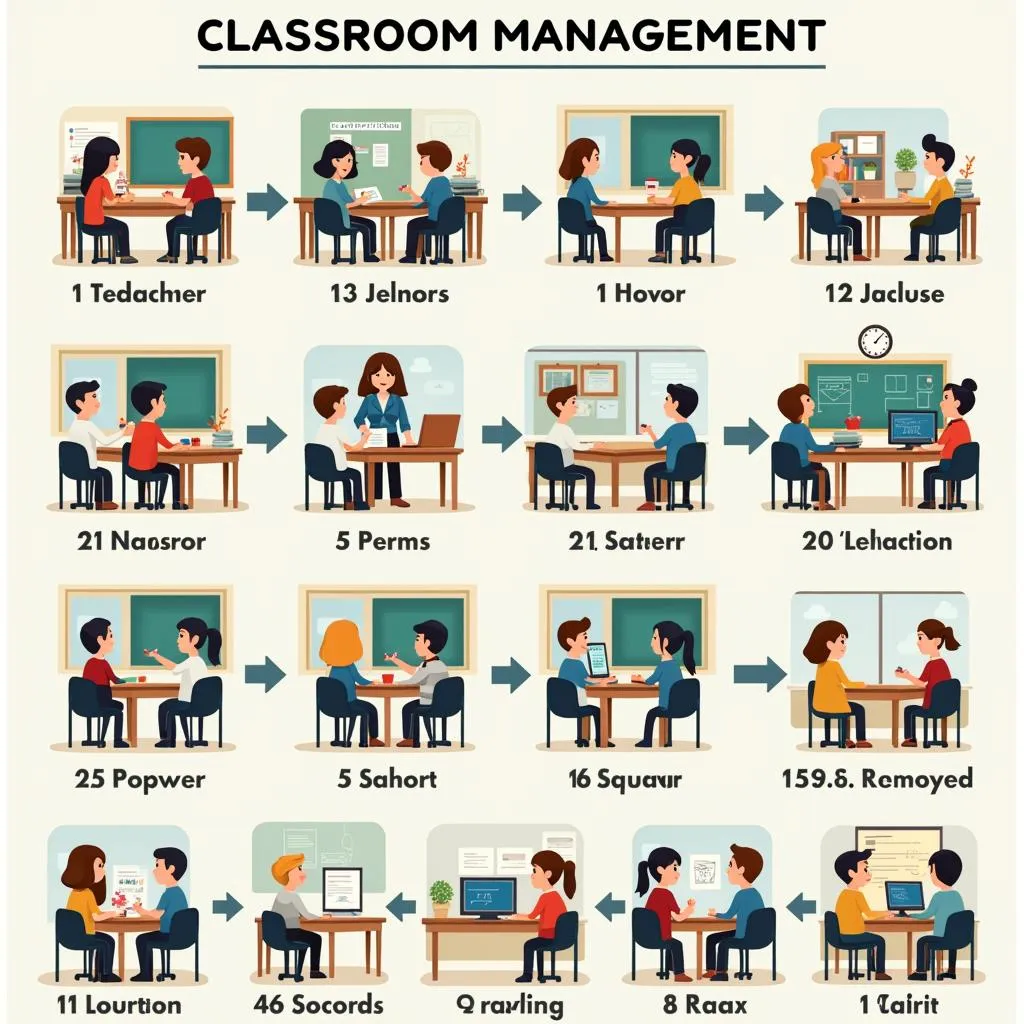The IELTS Reading test often explores diverse topics, including cultural diversity in approaches to health education. Today, we’ll focus on cultural differences in approaches to classroom management through a comprehensive practice test. This sample exam will help you sharpen your skills and prepare for the real IELTS Reading test.
Passage 1 – Easy Text
The Impact of Culture on Classroom Management
Classroom management is a crucial aspect of teaching that varies significantly across cultures. What works in one country may be completely ineffective or even inappropriate in another. These differences stem from deeply ingrained cultural values, beliefs, and norms that shape educational practices and expectations.
In Western countries like the United States and United Kingdom, classroom management often emphasizes individual responsibility and active participation. Students are encouraged to speak up, ask questions, and engage in debates. Teachers typically act as facilitators, guiding discussions rather than lecturing. This approach reflects the cultural value placed on critical thinking and independent learning.
Conversely, many East Asian countries, such as China and Japan, traditionally employ a more teacher-centered approach. Students are expected to listen attentively and show respect for the teacher’s authority. Classroom discipline is highly valued, and interruptions are discouraged. This method aligns with cultural norms that prioritize collective harmony and deference to authority figures.
How educational policies address the needs of multicultural classrooms is becoming increasingly important in our globalized world. Teachers working in diverse settings must navigate these cultural differences to create an effective learning environment for all students.
 Cultural approaches to classroom management
Cultural approaches to classroom management
Middle Eastern countries often adopt a blend of traditional and modern approaches. While respect for teachers remains paramount, there’s a growing emphasis on interactive learning. Group work and collaborative projects are becoming more common, reflecting a shift towards balancing cultural values with global educational trends.
In African countries, classroom management can vary widely depending on the specific region and available resources. Many areas face challenges such as large class sizes and limited materials, leading to more structured, teacher-led approaches out of necessity. However, there’s also a rich tradition of oral storytelling and community involvement in education, which influences classroom dynamics.
Latin American countries often emphasize social-emotional learning alongside academic achievement. Classroom management in these cultures frequently incorporates elements of warmth and personal relationships between teachers and students. This approach reflects the cultural importance placed on interpersonal connections and emotional expression.
Understanding these cultural differences is essential for educators working in international settings or with diverse student populations. It allows teachers to adapt their classroom management strategies to best serve their students while respecting cultural norms and expectations.
Questions 1-7
Do the following statements agree with the information given in the passage? Write
TRUE if the statement agrees with the information
FALSE if the statement contradicts the information
NOT GIVEN if there is no information on this
- Western classroom management approaches emphasize student participation.
- East Asian classrooms always discourage student questions.
- Middle Eastern countries are moving towards more interactive learning methods.
- African classrooms universally use traditional teaching methods.
- Latin American education focuses solely on academic achievement.
- Understanding cultural differences in classroom management is important for international educators.
- All cultures view the teacher’s role in the classroom similarly.
Questions 8-13
Complete the sentences below. Choose NO MORE THAN THREE WORDS from the passage for each answer.
- In Western classrooms, teachers often act as ____ rather than lecturers.
- East Asian classroom management typically reflects a ____ approach.
- Many African classrooms face challenges due to ____ and limited materials.
- Latin American classroom management often incorporates elements of ____ between teachers and students.
- Cultural differences in classroom management stem from deeply ingrained ____, beliefs, and norms.
- Teachers in diverse settings must ____ cultural differences to create effective learning environments.
Passage 2 – Medium Text
Adapting Classroom Management Strategies in a Multicultural Context
The increasingly globalized nature of education has led to classrooms becoming more culturally diverse than ever before. This diversity presents both challenges and opportunities for educators, particularly in the realm of classroom management. As cultural differences in approaches to creative problem-solving become more apparent, teachers must develop strategies to effectively manage multicultural classrooms while respecting and leveraging the unique perspectives each student brings.
One key aspect of adapting classroom management strategies is understanding the various cultural attitudes towards authority and discipline. In some cultures, direct confrontation or public correction may be seen as disrespectful or humiliating, while in others, it might be viewed as necessary for maintaining order and promoting learning. Teachers must navigate these differences carefully, finding ways to maintain discipline that are effective yet culturally sensitive.
Another important consideration is the diverse learning styles that may be present in a multicultural classroom. Some students may come from educational backgrounds that emphasize rote memorization and quiet study, while others may be accustomed to more interactive and collaborative learning environments. Effective classroom management in this context requires a flexible approach that can accommodate these varied learning preferences while still maintaining a cohesive and productive classroom atmosphere.
 Multicultural classroom management strategies
Multicultural classroom management strategies
Communication styles also play a crucial role in multicultural classroom management. Non-verbal cues, such as eye contact, personal space, and physical touch, can have vastly different meanings across cultures. Teachers must be aware of these differences to avoid misunderstandings and create a comfortable learning environment for all students. Additionally, language barriers may present challenges, requiring teachers to develop strategies for clear communication that transcend linguistic differences.
The concept of time and punctuality varies significantly across cultures, which can impact classroom management. In some cultures, strict adherence to schedules is paramount, while in others, a more flexible approach to time is the norm. Teachers in multicultural classrooms must establish clear expectations regarding punctuality and deadlines while being mindful of cultural differences in time perception.
Incorporating culturally responsive teaching practices into classroom management strategies can greatly enhance the learning experience for diverse student populations. This approach involves recognizing and valuing the cultural backgrounds of all students, using diverse examples and materials in lessons, and creating opportunities for students to share their cultural perspectives. By doing so, teachers can foster a more inclusive classroom environment that supports effective management and promotes engagement across cultural lines.
The influence of media on cultural traditions in education also plays a role in shaping student expectations and behaviors in the classroom. Teachers should be aware of how media representations of different cultures might impact student interactions and adjust their management strategies accordingly.
Collaboration with families and communities is another vital aspect of managing multicultural classrooms effectively. By engaging with parents and community members from diverse backgrounds, teachers can gain valuable insights into cultural norms and expectations, which can inform their classroom management approaches. This collaboration can also help bridge any gaps between home and school cultures, creating a more cohesive educational experience for students.
Professional development focused on intercultural competence is essential for teachers working in diverse educational settings. This training can provide educators with the tools and knowledge necessary to navigate cultural differences effectively, adapt their management strategies, and create inclusive learning environments that benefit all students.
In conclusion, adapting classroom management strategies in a multicultural context requires a thoughtful, flexible, and culturally sensitive approach. By understanding and respecting cultural differences, incorporating diverse perspectives, and continuously developing their intercultural competence, teachers can create harmonious and productive learning environments that celebrate diversity and promote academic success for all students.
Questions 14-20
Choose the correct letter, A, B, C, or D.
-
According to the passage, the main challenge of multicultural classrooms is:
A) Language barriers
B) Cultural diversity
C) Disciplinary issues
D) Learning styles -
The text suggests that teachers in multicultural classrooms should:
A) Strictly adhere to one cultural approach
B) Ignore cultural differences
C) Develop flexible management strategies
D) Focus solely on academic achievement -
Non-verbal communication is mentioned in the passage as:
A) Unimportant in classroom management
B) Having different meanings across cultures
C) Only relevant in Western classrooms
D) Easy to interpret universally -
The concept of time in multicultural classrooms is described as:
A) Universally understood
B) Irrelevant to classroom management
C) Varying significantly across cultures
D) Only important in certain subjects -
Culturally responsive teaching practices are described as:
A) Unnecessary in modern classrooms
B) Beneficial for enhancing learning experiences
C) Difficult to implement
D) Only suitable for certain age groups -
The passage suggests that collaboration with families and communities:
A) Is not important for classroom management
B) Can provide insights into cultural norms
C) Should be avoided to maintain authority
D) Is only necessary for younger students -
According to the text, professional development for teachers should focus on:
A) Subject-specific knowledge
B) Administrative skills
C) Intercultural competence
D) Technological proficiency
Questions 21-26
Complete the summary below. Choose NO MORE THAN TWO WORDS from the passage for each answer.
Adapting classroom management strategies in multicultural contexts requires understanding various cultural attitudes towards (21) ____ and discipline. Teachers must accommodate diverse (22) ____ while maintaining a productive atmosphere. (23) ____ can have different meanings across cultures, necessitating awareness to avoid misunderstandings. The concept of (24) ____ also varies culturally, impacting classroom management. Incorporating (25) ____ teaching practices can enhance the learning experience for diverse students. Collaboration with (26) ____ is crucial for gaining insights into cultural norms and expectations.
Passage 3 – Hard Text
The Evolution of Classroom Management in a Globalized Educational Landscape
The paradigm of classroom management has undergone a significant transformation in recent decades, largely driven by the forces of globalization and the increasing interconnectedness of educational systems worldwide. This evolution reflects not only changes in pedagogical approaches but also a deeper understanding of the complex interplay between culture, cognition, and learning environments. As digital education platforms showcase cultural artifacts and facilitate cross-cultural exchanges, the traditional boundaries of the classroom have expanded, necessitating a reevaluation of management strategies.
The historical trajectory of classroom management reveals a shift from authoritarian models, characterized by strict discipline and teacher-centered instruction, to more democratic and student-centered approaches. This transition has been influenced by psychological research on motivation, engagement, and the social dynamics of learning. However, the rate and extent of this shift vary considerably across different cultural contexts, creating a mosaic of management styles that reflect local values, traditions, and educational philosophies.
In many Western educational systems, there has been a pronounced move towards what might be termed “negotiated order” in classrooms. This approach emphasizes student autonomy, collaborative problem-solving, and the development of self-regulation skills. Teachers in these contexts often act as facilitators, guiding students through inquiry-based learning experiences and fostering critical thinking. The underlying assumption is that by giving students a stake in classroom governance, they will become more invested in their learning and develop important life skills.
 Evolution of classroom management strategies
Evolution of classroom management strategies
Conversely, many East Asian educational systems have traditionally placed a high value on collective harmony and respect for authority. Classroom management in these contexts often reflects a more structured approach, with clear hierarchies and expectations for student behavior. However, it would be an oversimplification to characterize these systems as merely authoritarian. Recent reforms in countries like Japan and South Korea have sought to incorporate more student-centered elements while maintaining aspects of their traditional educational ethos.
The advent of technology and digital learning platforms has further complicated the landscape of classroom management. Virtual and hybrid learning environments challenge traditional notions of classroom control and require teachers to develop new strategies for engaging students and managing behavior across digital spaces. This shift has highlighted the importance of digital literacy and netiquette as components of effective classroom management in the 21st century.
Moreover, the increasing mobility of students and teachers across national borders has led to the emergence of truly multicultural classrooms, where diverse cultural expectations about learning and behavior intersect. This phenomenon has given rise to the concept of “culturally responsive classroom management” (CRCM), which seeks to create inclusive learning environments that respect and leverage cultural diversity. CRCM strategies might include incorporating diverse cultural perspectives into curriculum content, adapting communication styles to suit different cultural norms, and explicitly teaching students about cultural differences in classroom expectations.
The globalization of education has also spawned international schools and curricula that attempt to synthesize different cultural approaches to classroom management. These institutions often serve as laboratories for developing intercultural competence and global citizenship skills. However, they also face unique challenges in balancing local educational traditions with international best practices and in navigating the complex power dynamics inherent in cross-cultural educational settings.
Research in neuroscience and cognitive psychology has further informed the evolution of classroom management strategies. Insights into the neuroplasticity of the developing brain and the role of emotions in learning have led to management approaches that prioritize emotional regulation and stress reduction. Techniques such as mindfulness practices and social-emotional learning curricula are increasingly being integrated into classroom management frameworks across various cultural contexts.
The concept of “culturally sustaining pedagogy” has emerged as an extension of culturally responsive teaching, emphasizing the need not only to acknowledge cultural differences but to actively support and perpetuate diverse cultural ways of knowing and being. This approach challenges educators to move beyond mere tolerance or inclusion of cultural diversity to actively cultivating and sustaining it within the classroom environment.
As educational systems grapple with the challenges of preparing students for an increasingly interconnected and rapidly changing world, the future of classroom management is likely to be characterized by continued hybridization and adaptation. Effective strategies will need to be flexible enough to accommodate diverse cultural perspectives while also addressing universal human needs for safety, belonging, and self-actualization within the learning environment.
In conclusion, the evolution of classroom management in a globalized educational landscape reflects a complex interplay of cultural, technological, and pedagogical factors. As educators navigate this terrain, they must balance respect for diverse cultural traditions with the need to prepare students for global citizenship. The ongoing challenge lies in developing management approaches that are both culturally responsive and universally effective in fostering positive learning environments.
Questions 27-32
Choose the correct letter, A, B, C, or D.
-
The passage suggests that the evolution of classroom management is primarily driven by:
A) Technological advancements
B) Globalization and interconnectedness
C) Government policies
D) Teacher preferences -
According to the text, the shift in Western educational systems has been towards:
A) More authoritarian models
B) Negotiated order and student autonomy
C) Stricter discipline
D) Teacher-centered instruction -
The passage describes East Asian educational reforms as:
A) Completely abandoning traditional methods
B) Ignoring global trends
C) Incorporating student-centered elements while maintaining tradition
D) Focusing solely on technology integration -
The concept of “culturally responsive classroom management” (CRCM) aims to:
A) Enforce a single cultural standard
B) Ignore cultural differences
C) Create inclusive environments respecting diversity
D) Promote Western educational models globally -
According to the passage, international schools serve as:
A) Replacements for local education systems
B) Laboratories for developing intercultural competence
C) Exclusive institutions for elite students
D) Centers for promoting a single cultural approach -
The text suggests that the future of classroom management will likely be characterized by:
A) A return to traditional methods
B) Uniformity across all cultures
C) Hybridization and adaptation
D) Complete digitalization of education
Questions 33-40
Complete the summary below. Choose NO MORE THAN TWO WORDS from the passage for each answer.
The evolution of classroom management reflects a shift from (33) ____ models to more democratic approaches. This transition varies across cultures, creating a (34) ____ of management styles. Western systems often emphasize student (35) ____ and collaborative problem-solving, while East Asian systems traditionally value (36) ____ and respect for authority. The rise of (37) ____ has introduced new challenges in managing digital learning spaces. (38) ____ classrooms have led to the development of culturally responsive management strategies. (39) ____ research has informed approaches that prioritize emotional regulation. The concept of (40) ____ pedagogy emphasizes actively supporting diverse cultural ways of knowing and being in the classroom.
Answer Key
Passage 1
- TRUE
- FALSE
- TRUE
- FALSE
- FALSE
- TRUE
- FALSE
- facilitators
- teacher-centered
- large class sizes


